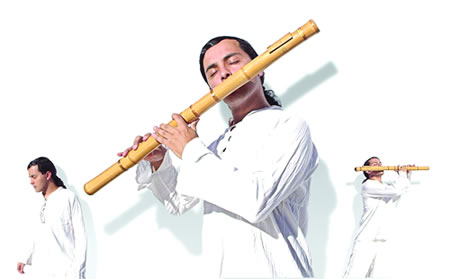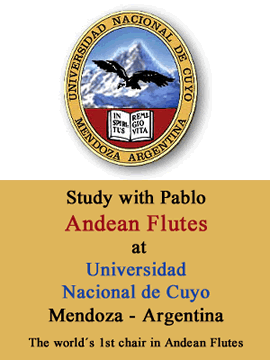
World Flutes Master

Take care of our enviroment

comprar

Peace web theme set courtesy of Crystal Cloud Graphics web set icon
Crystal Cloud Graphics
Crystal Cloud Graphics

Oboe
The oboe is a double reed musical instrument of the woodwind family. The English word "oboe" is a corruption of the French word for oboe, hautbois, which is a compound word made of haut meaning "high" and bois, meaning "wood". A musician who plays the oboe is called an oboist. Careful manipulation of embouchure and air pressure allows the player to express a large timbral and dynamic range. The oboe is often considered one of the most difficult instruments to learn to play.
The baroque oboe first appeared in French courts under Jean-Baptiste Lully in the late 17th century, where it was called hautbois. The basic form of the instrument was derived from the shawm, an instrument widely used in the Medieval and Renaissance periods. Musician and instrument maker Martin Hotteterre (d.1712) was responsible for many of the new instrument's early developments. The instrument quickly spread throughout Europe (including England, where it was called "hautboy" or "hoboy"). It was the main melody instrument in early military bands, until it was succeeded by the clarinet.
The oboe is a double reed musical instrument of the woodwind family. The English word "oboe" is a corruption of the French word for oboe, hautbois, which is a compound word made of haut meaning "high" and bois, meaning "wood". A musician who plays the oboe is called an oboist. Careful manipulation of embouchure and air pressure allows the player to express a large timbral and dynamic range. The oboe is often considered one of the most difficult instruments to learn to play.
The baroque oboe first appeared in French courts under Jean-Baptiste Lully in the late 17th century, where it was called hautbois. The basic form of the instrument was derived from the shawm, an instrument widely used in the Medieval and Renaissance periods. Musician and instrument maker Martin Hotteterre (d.1712) was responsible for many of the new instrument's early developments. The instrument quickly spread throughout Europe (including England, where it was called "hautboy" or "hoboy"). It was the main melody instrument in early military bands, until it was succeeded by the clarinet.

Classical Oboe, copy by Sand Dalton of an original by Johann Friedrich Floth, c. 1805
Other members of the oboe family
The oboe has several siblings. The most widely known today is the cor anglais, or English horn, the tenor (or alto) member of the family. A transposing instrument; it is pitched in F, a perfect fifth lower than the oboe. The oboe d'amore, the alto (or mezzo-soprano) member of the family, is pitched in A, a minor third lower than the oboe. J.S. Bach made extensive use of both the oboe d'amore as well as the taille and oboe da caccia, Baroque antecedents of the cor anglais. Even less common is the bass oboe (also called baritone oboe), which sounds one octave lower than the oboe. Delius and Holst both scored for the instrument. Similar to the bass oboe is the more powerful heckelphone, which has a wider bore and larger tone than the bass oboe. Only 165 heckelphones have ever been made, and competent players are hard to find [2]. The least common of all are the musette (also called oboe musette or piccolo oboe), the sopranino member of the family (it is usually pitched in E-flat or F above the oboe), and the contrabass oboe (typically pitched in C, two octaves deeper than the standard oboe).
Keyless folk versions of the oboe (most descended from the shawm) are found throughout Europe. These include the musette (France) and bombarde (Brittany), the piffaro and ciaramella (Italy), and the xirimia or chirimia (Spain). Many of these are played in tandem with local forms of bagpipe. Similar oboe-like instruments, most believed to derive from Middle Eastern models, are also found throughout Asia as well as in North Africa.
This article is licensed under the GNU Free Documentation License. It uses material from the Wikipedia article "Metasyntactic variable"
The oboe has several siblings. The most widely known today is the cor anglais, or English horn, the tenor (or alto) member of the family. A transposing instrument; it is pitched in F, a perfect fifth lower than the oboe. The oboe d'amore, the alto (or mezzo-soprano) member of the family, is pitched in A, a minor third lower than the oboe. J.S. Bach made extensive use of both the oboe d'amore as well as the taille and oboe da caccia, Baroque antecedents of the cor anglais. Even less common is the bass oboe (also called baritone oboe), which sounds one octave lower than the oboe. Delius and Holst both scored for the instrument. Similar to the bass oboe is the more powerful heckelphone, which has a wider bore and larger tone than the bass oboe. Only 165 heckelphones have ever been made, and competent players are hard to find [2]. The least common of all are the musette (also called oboe musette or piccolo oboe), the sopranino member of the family (it is usually pitched in E-flat or F above the oboe), and the contrabass oboe (typically pitched in C, two octaves deeper than the standard oboe).
Keyless folk versions of the oboe (most descended from the shawm) are found throughout Europe. These include the musette (France) and bombarde (Brittany), the piffaro and ciaramella (Italy), and the xirimia or chirimia (Spain). Many of these are played in tandem with local forms of bagpipe. Similar oboe-like instruments, most believed to derive from Middle Eastern models, are also found throughout Asia as well as in North Africa.
This article is licensed under the GNU Free Documentation License. It uses material from the Wikipedia article "Metasyntactic variable"








